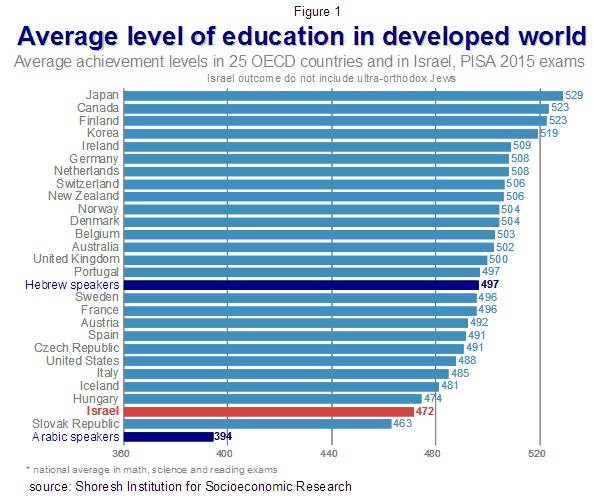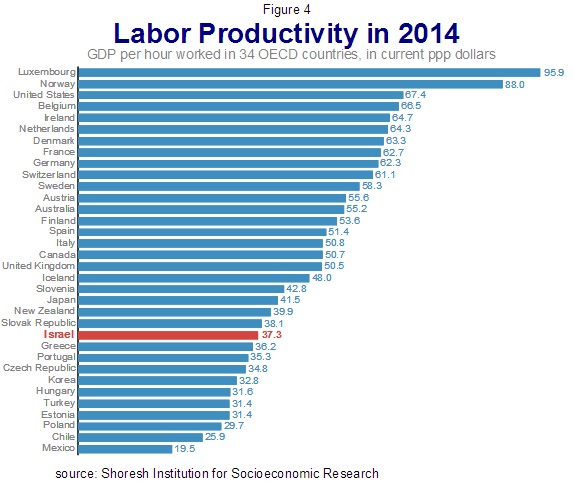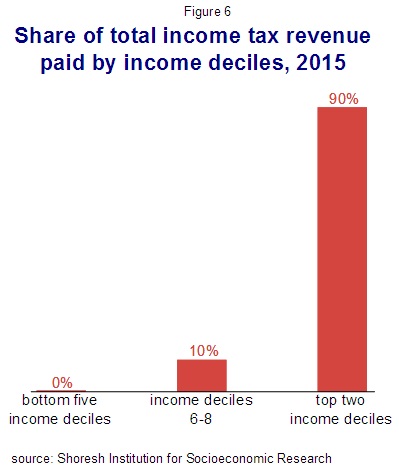The One-State Solution: by Dan Ben-David The
demographic and national defense paradigms that still frame much of the
discourse on Israel are archaic. They ignore the fact that even without the
addition of millions of poorly skilled and educated Palestinians, Israel’s
current population is already situated on an unsustainable socioeconomic
trajectory. One of the key issues that gets lost
in the debate on the pros and cons of annexing the West Bank is that Israel’s
very future is unsustainable, even if the country remains on its current,
default, trajectory. Annexation would
simply hasten that future. The public
discourse within Israel and outside of it focuses on an outdated demographic
paradigm based on simple head-counts of Jews and Arabs rather than on the much
more crucial and fundamental fact that, already today, there are too few
persons in Israel with the knowledge and skills to work in a modern,
competitive, global economy. This is ultimately the issue that will
determine whether the Israel of our grandchildren will even exist – Jewish,
democratic, or otherwise. What is
transpiring today in Israel is analogous to an endless argument about the
rearrangement of deck chairs on the Titanic instead of a focus on that big
iceberg ahead and the urgent need for the entire ship to change course before
it is too late. Ostensibly, Israel has one of the most
educated populations on the planet.
Among prime working age adults in Israel, the average number of school
years is one of the highest in the developed world while the share of academic
degree holders is near the world’s pinnacle.
Unfortunately, this is a shallow perspective that is both antiquated and
misleading. In a society inundated with
facts, distinguishing between chaff and root issues can be challenging – and
not all is as it may seem. The
all-too-common focus on the quantity of education tends to mask the vitally
important issue of quality. A
data-driven tour of Israel’s current population characteristics can be an
eye-opener. Year after year, for decades on end,
the knowledge level of Israeli children in core educational subjects (math,
science and reading) has been at the bottom of the developed world (Figure
1). The average achievement of
Arab-Israeli children (that is, Israeli citizens, not Palestinians) is below
that of many 3rd world countries.
So many Haredi (ultra-Orthodox) children do not study the core
curriculum beyond 8th grade that most do not even participate in the
international exams – which means that the actual situation in Israel is
substantially worse than what even the current data show. 
Look not at the demographics of the
adults but at those of the children, for they are our future. Today, Arab-Israeli and Haredi children
account for almost half of Israel’s first graders (Figure 2). Add to them a very large number of Jewish
non-Haredi children in the country’s geographic and social peripheries
receiving an extremely poor education and you may begin to understand the
magnitude of what is coming down the pike when all of these children grow up. 
Even without the Haredim, Israel has
the largest educational inequality – by far – in the de veloped world (Figure 3). Had the Haredim taken the exams, this
education gap would be even higher than what the current data indicate. This has tremendous economic consequences for
the future. The children receiving the
poorest education in Israel are not only a huge share of the total number of
children, they also tend to belong to the larger families – and hence, to the
fastest growing parts of the population. 
The
other Israel This is picture of two Israel’s in
one. It includes the start-up nation,
with its cutting-edge universities, phenomenal high-tech and a path-breaker in
the fields of medicine. It also includes
a Second Israel, one that is not receiving the tools to work in a modern
economy. This latter part of Israel is
extraordinarily large and its relative share in the total is getting larger by
the year. Consequently, it is not a
coincidence that despite being home to the start-up nation, the country’s
overall labor productivity is among the lowest in OECD (Figure 4). 
The fact that we are leaving so many
people behind is not just reflected in high rates of poverty and income
inequality. It dampens our overall
economic growth. The nation’s collective
ability to assimilate, utilize and develop new technologies (not just in
high-tech sectors) is diminished when the national engine is running on fewer
and fewer cylinders that could otherwise have been available to it. Many more individuals could have found
a place in this economy had they been provided the necessary conditions. Instead of providing an economic boost to
themselves and to the nation as a whole, they become a weight that has been
steadily growing over time. Not only
does this result in low national productivity, it is a growing weight that has
been steadily dragging Israel further and further behind the G7 countries for
the past four decades (Figure 5). 
The implications are ominous and
foretell an unsustainable future.
Israel’s tax revenues are more heavily dependent on indirect taxes (such
as VAT and sales taxes) which are considered regressive (i.e. they place a
heavier relative burden on the poor than on the rich). Therefore, future tax increases needed to
fund a growing population lacking the basic skills and education will have to
come from direct taxes – and herein lies the other problem. Even before tomorrow arrives, half of
Israel’s current population is so poor that it do not even reach the bottom
rung of the income tax ladder. It does
not pay any income tax at all. In fact,
90% percent of all Israel’s income tax revenues today come from just 20% of the
population (Figure 6). These are
primarily the skilled and educated, many of whom could find jobs abroad, should
Israel increase the burden on their shoulders beyond limits that they are willing
to bear. 
The
economically untenable one-state option It is important to emphasize that
these very existential threats exist even without the addition of several
million unskilled and poorly educated Palestinians in a one-state
solution. Aside from the obvious
security concerns that such a population mix would entail, this scenario would
prevent the establishment of an independent Palestinian state. Israel would then be forced to choose between
two options – neither economically viable. The first option would be to grant
full citizenship, including the right to vote, with all of its attendant
implications. It also entails the
provision of complete access to Israel’s health, welfare and education services
to all those living between the Mediterranean Sea and the Jordan River. But who will then be able to fund the
magnitude of such services that the enlarged – and poor – population of Israel
would require? The other option is not to grant
citizenship. While too many Israelis are
oblivious, or willfully ignorant, of the very problematic moral and ethical
implications of denying basic rights to the entire population, other countries
that Israel is so dependent upon for trade will not be so sanguine. This would create a problem that great number
of Israelis have yet to fully comprehend.
Like other small countries, Israel does not have the capacity to produce
all of its own needs, nor is its domestic market sufficiently large to cover
the costs of producing those needs.
Current threats of sanctions on the settlements will inevitably turn
into a full-fledged ostracism of the entire country – which will signal the end
of developed world living standards for Israel.
More than likely, this would include an embargo that will severely
impede Israel’s ability to retain the qualitative military advantage that
ensures its survival. In a world in
which anti-Semitism is becoming increasingly rampant, who in his right mind
wants to lob up that eventual slam dunk on the heads of all of us? Looking
ahead The bottom line is that we have been
asking the wrong questions for quite a while.
The basic paradigms have changed while most people were sleeping. Specifically, it is not just the demographic
paradigm that has shifted. The national
security paradigm – which is what ultimately determines all Israeli elections –
has changed as well. National security
is not just how many planes and tanks we have.
If half of the children in Israel are receiving a 3rd world
education today, then they will only be able to maintain a 3rd world
economy tomorrow. But a 3rd world
economy will not be able to support the 1st world army that Israel will need to
literally remain alive in the world’s most dangerous region. This is national security, redefined – and it
exists even before one Palestinian receives Israeli citizenship. Second Israel’s share of the country’s
current population is already approaching untenable proportions. The eventual peace agreement will need
to include minor land swaps around the pre-1967 border. Nevertheless, it should be clear that the
issue of settlements deep inside the West Bank has nothing to do with defending
Israel. The opposite is the case. The settlements’ particular geographic
vulnerabilities require the army to spread its limited resources even
further. In light of the missiles
showered upon Israel after it unilaterally withdrew from Lebanon and Gaza,
there should not be any military withdrawal from the West Bank as long as there
is no peace. However, the time has come
to move the civilians out of there and back into Israel. This is entirely from the perspective of what
is good for Israel. If it also benefits
the prospects of peace, so much the better. Israel’s future is not etched in
stone. It is still in our hands –
Israeli hands – if we get our act together, change our national priorities and
the catastrophic socioeconomic trajectory that we are currently on. Until then, our current default is that
iceberg straight ahead. The one-state
solution is simply akin to putting our Titanic on jet skis toward the iceberg. |